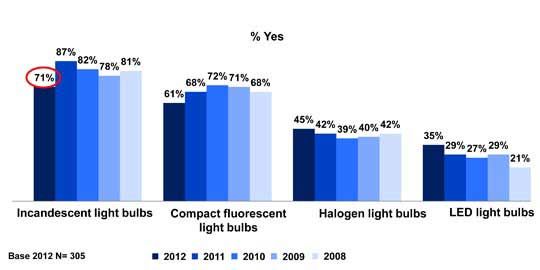The penetration of incandescent light bulbs in American homes has dropped significantly in the past year, according to a new survey from Sylvania. The survey shows that 29 percent of U.S. households are free of incandescent bulbs.
However, there are still many Americans who are unaware of the phase-out of energy inefficient light bulbs, even as concerns about energy efficiency increase. These findings from Sylvania highlight the slow but steady shift when it comes to consumer attitudes toward lighting.
More people are replacing light bulbs because of lighting quality or for energy efficiency. The four most important considerations are: the amount of time the bulb will last; the bulb's brightness; the amount of energy the bulb uses; and the cost. Although people say they are more concerned about energy use than cost, less than half of the respondents say they care if there is an Energy Star label on the product they select.
According to the survey, awareness of light-emitting diode (LED) options dropped in 2012, from 80 percent to 69 percent. At the same time, the number of homes with LED bulbs rose from 20 percent in 2008 to 35 percent in 2012.
The small phone survey of about 300 people makes it hard to know if changes from past years are indicative of larger trends. Sylvania says it is 95 percent confident about the figure showing that 29 percent of households go without incandescent bulbs.

In coming years, as the incandescent goes extinct, LEDs will gain traction as they commandeer real estate on store shelves. Ikea announced last year it will phase out all non-LED lighting by 2016, and stores like Wal-Mart are increasing their LED offerings.
More offerings on the shelves, coupled with falling prices and increased utility rebates, will mean that for the average consumer, LEDs will be a viable option when that old incandescent burns out.



